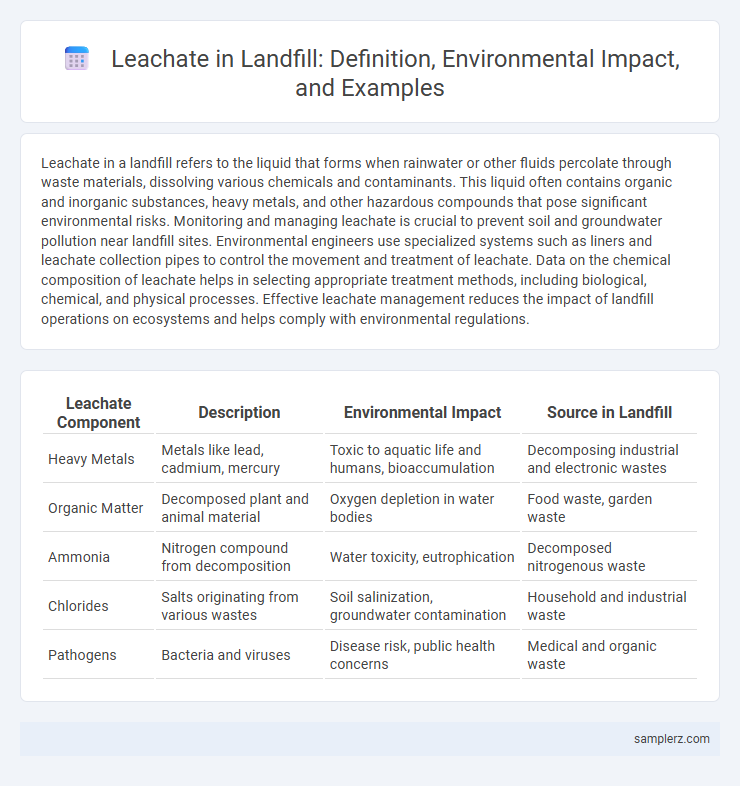Leachate in a landfill refers to the liquid that forms when rainwater or other fluids percolate through waste materials, dissolving various chemicals and contaminants. This liquid often contains organic and inorganic substances, heavy metals, and other hazardous compounds that pose significant environmental risks. Monitoring and managing leachate is crucial to prevent soil and groundwater pollution near landfill sites. Environmental engineers use specialized systems such as liners and leachate collection pipes to control the movement and treatment of leachate. Data on the chemical composition of leachate helps in selecting appropriate treatment methods, including biological, chemical, and physical processes. Effective leachate management reduces the impact of landfill operations on ecosystems and helps comply with environmental regulations.
Table of Comparison
| Leachate Component | Description | Environmental Impact | Source in Landfill |
|---|---|---|---|
| Heavy Metals | Metals like lead, cadmium, mercury | Toxic to aquatic life and humans, bioaccumulation | Decomposing industrial and electronic wastes |
| Organic Matter | Decomposed plant and animal material | Oxygen depletion in water bodies | Food waste, garden waste |
| Ammonia | Nitrogen compound from decomposition | Water toxicity, eutrophication | Decomposed nitrogenous waste |
| Chlorides | Salts originating from various wastes | Soil salinization, groundwater contamination | Household and industrial waste |
| Pathogens | Bacteria and viruses | Disease risk, public health concerns | Medical and organic waste |
Understanding Leachate: Definition and Formation
Leachate is a contaminated liquid generated when water percolates through landfill waste, dissolving organic and inorganic substances. It typically contains hazardous chemicals, heavy metals, and pathogens, posing significant risks to soil and groundwater quality. Understanding leachate formation involves recognizing the role of waste composition, moisture content, and landfill design in influencing its volume and toxicity.
Common Sources of Leachate in Landfills
Leachate in landfills commonly originates from decomposing organic waste, including food scraps, yard trimmings, and paper products. Rainwater infiltration through waste layers further enhances leachate production by dissolving soluble materials and contaminants. Industrial waste and hazardous substances disposed of improperly also contribute significant toxic components to landfill leachate.
Chemical Composition of Landfill Leachate
Landfill leachate contains a complex mixture of organic and inorganic compounds, including heavy metals like lead, cadmium, and mercury, as well as ammonia, nitrates, and chlorides. High concentrations of biodegradable organic matter, measured as biochemical oxygen demand (BOD) and chemical oxygen demand (COD), characterize the leachate's chemical profile. This toxic mixture poses significant risks to groundwater quality and requires effective treatment before disposal.
Case Studies: Real-World Leachate Incidents
Leachate contamination was documented in the 1980 Love Canal disaster, where toxic waste seeped into residential areas, causing severe health issues. The 2015 Al-Qassim landfill in Saudi Arabia experienced groundwater pollution due to inadequate leachate management, prompting urgent environmental remediation. These case studies highlight the critical need for advanced leachate treatment technologies and stringent landfill design regulations to prevent ecological damage.
Environmental Impact of Leachate Leakages
Leachate from landfills contains hazardous chemicals, heavy metals, and organic pollutants that can contaminate soil and groundwater, posing serious risks to ecosystems and human health. Leachate leakages contribute to the degradation of aquatic habitats by introducing toxic substances that disrupt biological processes and reduce biodiversity. Uncontrolled leachate seepage exacerbates the accumulation of pollutants in the environment, leading to long-term ecological damage and costly remediation efforts.
Groundwater Contamination from Leachate
Leachate from landfills, a toxic liquid formed by water percolating through waste, often contains hazardous chemicals and heavy metals that can infiltrate groundwater sources. This contamination poses significant risks to drinking water supplies, leading to potential health hazards such as heavy metal poisoning and exposure to organic pollutants. Effective landfill management and leachate treatment systems are essential to prevent groundwater pollution and protect environmental and public health.
Leachate Collection and Treatment Technologies
Leachate in landfills is a highly contaminated liquid formed by the percolation of water through waste, requiring advanced collection and treatment technologies to prevent environmental pollution. Leachate collection systems typically consist of perforated pipes and drainage layers designed to efficiently capture and divert leachate to treatment facilities. Treatment technologies such as biological processes, reverse osmosis, and constructed wetlands are employed to remove organic compounds, heavy metals, and nutrients, ensuring safe discharge or reuse of treated leachate.
Regulatory Standards for Landfill Leachate
Landfill leachate is regulated under stringent environmental standards such as the Resource Conservation and Recovery Act (RCRA) and the Clean Water Act (CWA) in the United States, which mandate limits on contaminant concentrations including heavy metals, ammonia, and organic compounds. Regulatory agencies require landfill operators to implement leachate collection, treatment systems, and regular monitoring to prevent groundwater and surface water contamination. Compliance involves tracking parameters like biochemical oxygen demand (BOD), total dissolved solids (TDS), and pH levels to ensure adherence to permissible discharge levels and protect ecosystems.
Best Practices for Leachate Management
Leachate management in landfills involves the collection and treatment of contaminated water to prevent soil and groundwater pollution, using engineered liners and leachate collection systems. Implementing biological treatment methods such as aerobic and anaerobic processes effectively reduces organic contaminants and heavy metals. Regular monitoring and maintenance of leachate collection infrastructure ensure compliance with environmental regulations and protect surrounding ecosystems.
Future Challenges in Leachate Control
Leachate in landfills presents future challenges including the increasing complexity of chemical contaminants due to emerging waste streams and microplastics infiltration. Advanced treatment technologies such as membrane bioreactors and advanced oxidation processes require optimization for cost-effectiveness and energy efficiency. Regulatory frameworks will need enhancement to address long-term monitoring and control of leachate composition to protect groundwater and ecosystems.

example of leachate in landfill Infographic
 samplerz.com
samplerz.com